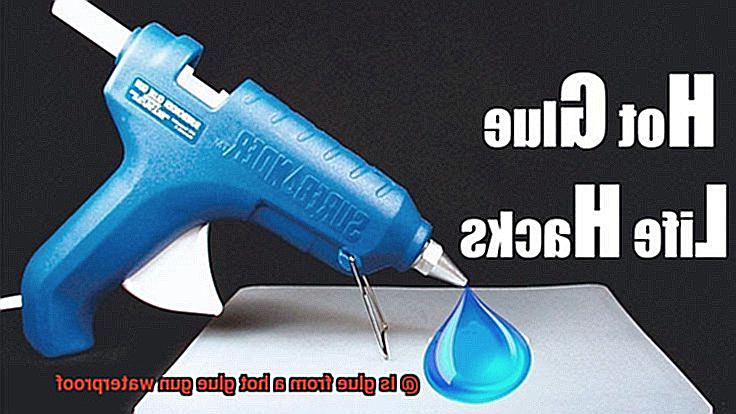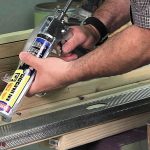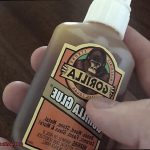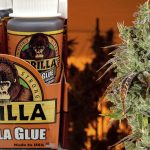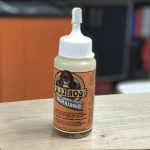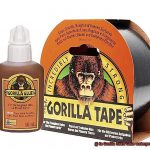Have you ever found yourself in the midst of a DIY project, wondering if the hot glue you’re using is truly waterproof? With conflicting information on the internet, it can be tough to know what to believe. But fear not. We’ve got you covered.
In this blog post, we’ll delve into the world of hot glue and explore its waterproofing capabilities. We’ll start by covering the basics of hot glue guns and how they work, along with their various applications. Then, we’ll discuss the difference between waterproof and water-resistant and how that plays into our understanding of hot glue.
Whether you’re an experienced DIY pro or just starting out on your crafting journey, join us as we explore everything you need to know about hot glue waterproofing. By the end of this post, you’ll have all the information necessary to confidently tackle any project that involves exposure to water. So let’s get started.
What is Hot Glue?
Contents
- 1 What is Hot Glue?
- 2 Is Hot Glue Waterproof?
- 3 Factors That Determine Hot Glue’s Water Resistance
- 4 Types of Hot Glue with Improved Water Resistance
- 5 Temperature Settings and Their Impact on the Adhesive’s Water Resistance
- 6 Tips for Using Hot Glue in Wet Environments
- 7 Sealing a Bonded Area to Improve Water Resistance
- 8 Conclusion
Hot glue is a remarkable adhesive that is widely used in crafting, construction, and other industries. It is made up of different components, including thermoplastic polymers, resins, and stabilizers. These components are heated until they melt and become fluid, allowing the glue to be applied to surfaces.
One of the significant advantages of hot glue is its quick-drying properties. Unlike other adhesives that can take several hours to dry, hot glue dries in a matter of seconds to a minute. This makes it an ideal choice for situations where a fast bond is needed.
Another reason why hot glue is widely used is its versatility. It can be used on various surfaces such as wood, metal, plastic, and fabric. Hot glue can help you achieve a strong and lasting bond for your DIY projects from building furniture to creating handmade gifts.
However, it’s important to note that hot glue may not be suitable for all projects. For instance, if you’re working on an outdoor project or an item that will be exposed to moisture, it’s crucial to select the right type of glue and apply it correctly. Although hot glue can resist some water exposure, it may not provide a waterproof bond.
Is Hot Glue Waterproof?
When it comes to water exposure, people often wonder if hot glue is up to the task. As an expert on the subject, I can tell you that the answer is not as simple as a straightforward “yes” or “no.”
To begin with, it’s important to know that hot glue is not inherently waterproof. Most hot glue formulas are made from thermoplastic polymers and synthetic resins that are water-soluble. So, if they come into contact with water, they can soften and lose their adhesive properties.
However, some hot glue formulas are designed to be more water-resistant than others. Industrial-grade hot glues often include additives that make them more resistant to water and moisture. These types of hot glue can be used for outdoor projects or in damp environments without losing their adhesive strength.
The surface that the hot glue is applied to can also affect its ability to withstand water and moisture. If hot glue is applied to a porous or absorbent surface, such as fabric or paper, it may not be as water-resistant as if it were applied to a non-porous surface like plastic or metal.
So, what does this mean for your DIY projects? When using hot glue for something that will be exposed to water or moisture, consider both the formula of the hot glue and the surface it will be applied to. Industrial-grade hot glues with additives can provide better resistance against water and moisture. Additionally, non-porous surfaces like plastic or metal will offer better adhesion than porous surfaces like fabric or paper.
Factors That Determine Hot Glue’s Water Resistance
As an expert in this field, I’ve done some research and compiled a list of factors that can affect the water resistance of hot glue.
Firstly, the type of hot glue being used is crucial. Some hot glues are designed specifically to be waterproof, while others are not. It’s important to check the label or packaging of the hot glue to determine if it’s waterproof or not.
Secondly, the temperature at which the hot glue is applied plays a significant role in its water resistance. Hot glue that is applied at a high temperature will typically have better water resistance than that applied at a lower temperature. The higher temperature causes the glue to solidify quickly and create a stronger bond.
The amount of glue used also affects its water resistance. Too little glue may not create a strong enough bond to withstand exposure to water, while too much glue may take longer to dry and may not create a strong bond either.
The surface being glued also affects its water resistance. Porous surfaces like wood or fabric may absorb hot glue, reducing its water resistance. On the other hand, non-porous surfaces like metal or plastic typically provide better water resistance when using hot glue.
Lastly, the environment in which the glued item will be exposed matters too. Hot glue that is exposed to extreme temperatures or humidity may weaken over time and lose its water resistance.
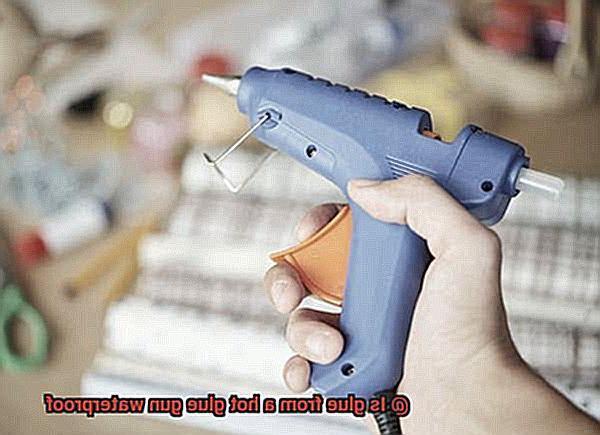
Types of Hot Glue with Improved Water Resistance
If you’re planning on undertaking a DIY project that will be exposed to water or moisture, it’s important to choose the right type of hot glue with improved water resistance. There are several types of hot glue available in the market, and each one has its own level of water resistance.
The first type of hot glue with improved water resistance is the standard hot glue. While it can resist a small amount of water, it is best suited for indoor projects or items that will not be exposed to water for long periods. Standard hot glue is perfect for smaller projects such as attaching decorations to surfaces or fixing broken household items.
The second type of hot glue with improved water resistance is high-temperature hot glue. This type of glue is more water-resistant than standard hot glue and can withstand exposure to outdoor elements such as rain and humidity. High-temperature hot glue is ideal for use in outdoor furniture repair or sealing garden ornaments that are exposed to moisture regularly.
The third type of hot glue with improved water resistance is marine-grade hot glue. This type of glue is specifically designed for use in water-related projects such as boat building or repairing pool equipment. Marine-grade hot glue is highly resistant to water, saltwater, and UV radiation, making it perfect for use in harsh marine environments.
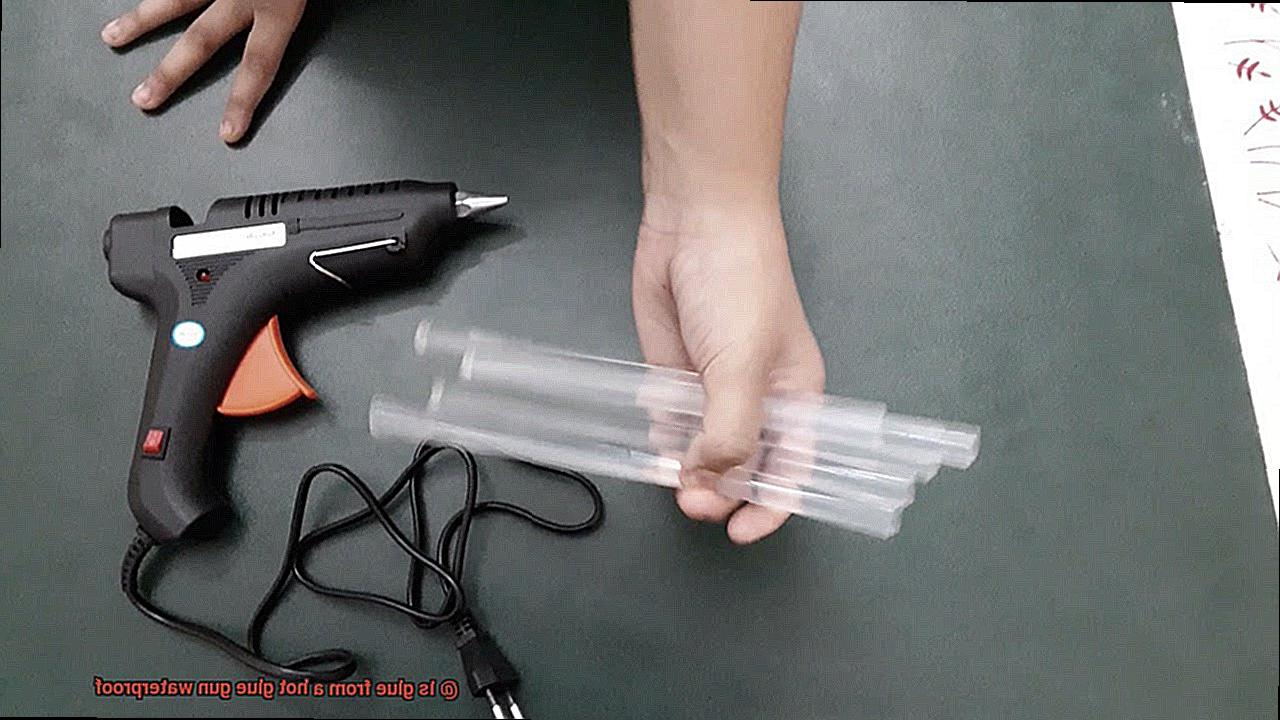
Another type of hot glue with improved water resistance is epoxy-based hot glue. This type of glue sets hard and has excellent adhesion properties, making it ideal for projects requiring a strong bond and regular exposure to water or moisture. Epoxy-based hot glue is perfect for repairing broken ceramic items or bonding metal surfaces.
When choosing a hot glue with improved water resistance, it’s important to read the label carefully to ensure that it is suitable for your specific application. Additionally, following the manufacturer’s instructions carefully when applying the glue will ensure that it dries correctly and holds up well even in wet conditions.
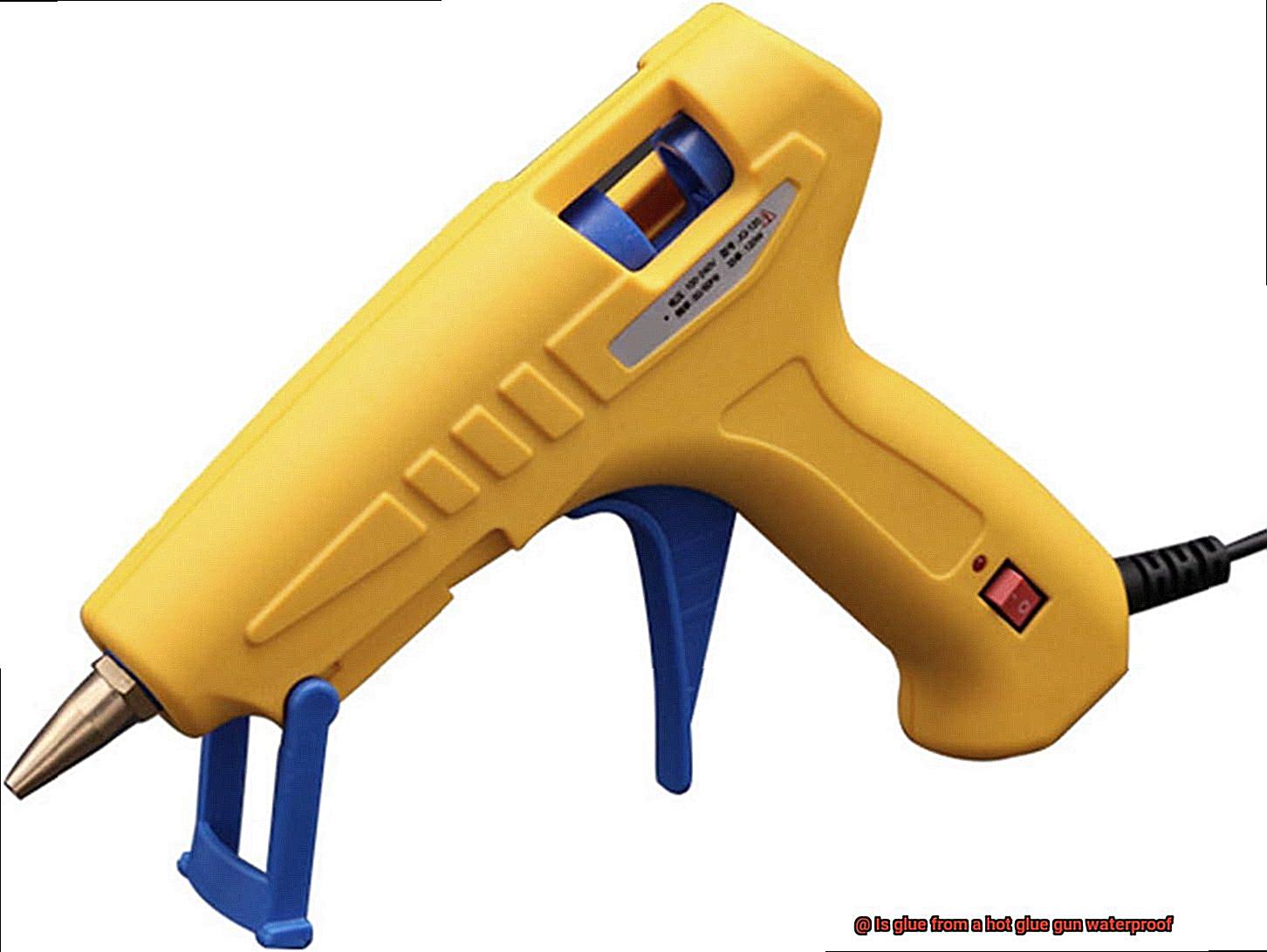
Temperature Settings and Their Impact on the Adhesive’s Water Resistance
Hot glue guns generally come with two temperature settings: high and low. The high setting is ideal for bonding materials that require a stronger and more durable bond, while the low setting is used for bonding delicate materials that may melt or get damaged when exposed to high temperatures. However, it’s important to understand that the water resistance of the adhesive depends on the temperature setting used during the bonding process.
Let’s talk about water resistance. Hot glue from a hot glue gun is not completely waterproof but rather water-resistant. The ability of the adhesive to resist water depends on the temperature setting used during the bonding process. When using a high-temperature setting, the adhesive forms a stronger bond that is more resistant to water. This is because the high temperature allows the glue to penetrate deeper into the material, creating a stronger bond.
On the other hand, when using a low-temperature setting, the bond created may not be as strong and therefore less water-resistant. It’s essential to note that even with higher temperature settings, hot glue gun adhesive may not be entirely waterproof. Therefore, if you plan on using hot glue for projects that will be exposed to water or moisture frequently, it may be best to use additional waterproofing measures such as sealants or coatings.
In summary, temperature settings play a vital role in determining the water resistance of hot glue gun adhesive. While higher temperatures may provide a stronger and more durable bond, it’s important to keep in mind that hot glue gun adhesive is not completely waterproof. Therefore, additional waterproofing measures may need to be taken for projects that will be exposed to water or moisture frequently.
To ensure your project stands up against whatever nature throws its way, try these tips:
- Use a high-temperature setting for stronger and more durable bonds
- Consider additional waterproofing measures such as sealants or coatings for projects that will be exposed to water or moisture frequently
- Remember that hot glue gun adhesive is water-resistant, not entirely waterproof
Tips for Using Hot Glue in Wet Environments
Using hot glue in wet environments can be a challenging task, but with the right techniques and materials, it can be accomplished effectively. Here are some tips to help you use hot glue in damp or wet conditions:
Use a Waterproof Hot Glue
When working in moist or wet conditions, it’s crucial to use a waterproof hot glue gun and glue sticks specifically designed for use in water or high humidity. This type of glue stick usually has a stronger adhesive and can resist exposure to moisture.
Clean and Dry Surface
Before applying hot glue, ensure that the surface you’re gluing is completely clean and dry. Any debris or moisture on the surface could weaken the bond between the glue and the material. You can use a clean cloth or paper towel to wipe down the area before applying the hot glue.
Allow Adequate Drying Time
It’s important to allow ample time for hot glue to dry and set before exposing it to any moisture. The drying time can vary depending on the brand and type of hot glue used, so it’s important to read the manufacturer’s instructions for drying time.
Consider Temperature
Hot glue may not bond as well in colder temperatures, so it’s important to keep the materials being glued and the hot glue gun at a warm, consistent temperature. This will help ensure that the hot glue bonds properly.
Apply Waterproof Sealant
If you’re working in an extremely wet environment, such as underwater, applying a waterproof sealant or topcoat over the hot glue once it has dried can provide an extra layer of protection against water damage. This can be especially useful if the glued item will be exposed to water or dampness on a regular basis.
Choose the Right Hot Glue
Selecting the right type of hot glue for wet environments is crucial. Look for brands that have added waterproofing agents or are specifically designed for outdoor use. These types of hot glue can ensure that your bond is strong and can withstand exposure to moisture.
Sealing a Bonded Area to Improve Water Resistance
Hot glue is a popular adhesive used to bond surfaces together. However, this adhesive is not inherently waterproof, and prolonged exposure to water or moisture can cause the bond to break down. But fear not. By sealing the bonded area with a waterproof coating or sealant, you can improve the water resistance of your hot glue bond and make it more durable.
To begin, let’s discuss the properties of hot glue. It is a thermoplastic adhesive that creates a strong bond when applied to surfaces. However, the synthetic polymers that make up hot glue are not completely impervious to water, which can cause the adhesive to lose its bonding strength over time.
To prevent this from happening, it is essential to seal the bonded area with a waterproof coating or sealant. You can accomplish this by either applying a layer of silicone sealant over the hot glue bond or using a waterproofing spray designed for fabrics and other materials.
It’s important to note that while sealing the bonded area can improve water resistance, it may not make the bond completely waterproof. The effectiveness of the sealant depends on factors such as the type of surface being bonded and the amount of exposure to water or moisture.
To ensure your bond remains strong and durable, you should take preventative measures to protect it from water damage. Here are some helpful tips:
- Avoid exposing the bond to water whenever possible.
- Store items in a dry location.
- Use additional waterproofing measures like waterproof tape or covers.
By following these tips and properly sealing your bonded area, you can create a robust and long-lasting bond that can withstand various environmental conditions.
Also Read: Is Hot Glue Toxic? – Glue Things
Conclusion
In summary, hot glue is a highly versatile adhesive that can be used for a multitude of DIY projects. However, when it comes to water exposure, it’s crucial to understand the difference between waterproof and water-resistant and how these factors affect the hot glue’s ability to withstand moisture.
Although most hot glue formulas are not inherently waterproof, there are industrial-grade hot glues with additives that can provide better resistance against water and moisture. Furthermore, non-porous surfaces like plastic or metal typically offer better adhesion than porous surfaces like fabric or paper.
When selecting a hot glue with improved water resistance, it’s essential to read the label carefully to ensure that it is suitable for your specific application. Additionally, temperature settings play a pivotal role in determining the water resistance of hot glue gun adhesive. While higher temperatures may provide a stronger and more durable bond, it’s vital to keep in mind that hot glue gun adhesive is not entirely waterproof.
By adhering to best practices such as using waterproof hot glue sticks, preparing surfaces appropriately before applying hot glue, allowing sufficient drying time, considering temperature conditions, using sealants or coatings over the bond area, and taking preventative measures against water damage, you can create robust bonds that can withstand various environmental conditions.

